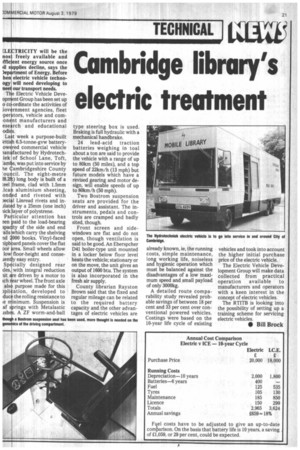Cambridge library's
Page 23

If you've noticed an error in this article please click here to report it so we can fix it.
electric treatment ;7..LECTRICITY will be the nost freely available and !Mc tent energy source once oil supplies decline, says the )epartment of Energy. Before hen electric vehicle technoogy will need developing to fleet our transport needs.
The Electric Vehicle Deveopment Group has been set up o co-ordinate the activities of ;overnment agencies, fleet ,perators, vehicle and corn onent manufacturers and esearch and educational °dies.
Last week a purpose-built ritish 6.5-tonne-gvw battery owered commercial vehicle lanufactured by Hydrotechiek of School Lane, Toft, :ambs, was put into service by ne Cambridgeshire County :ouncil. The eight-metre ?.8.2ft) long body is built of a :eel frame, clad with 1.5mm .1can aluminium sheeting, onded and riveted with )ecial Linread rivets and inilatecl by a 25mm (one inch) lick layer of polystrene.
Particular attention has een paid to the load-bearing Tacky of the side and end -ails which carry the shelving rid 2000 books. Vinyl-faced iipboard panels cover the flat Dor area. Small wheels allow low floor-height and conselently easy entry.
Specially designed rear des, with integral reduction lit are driven by a motor to Leh rear wheel. The front axle also purpose made for this )plication, developed to duce the rolling resistance to Le minimum. Suspension is af springs with Metalastic Ishes, A ZF worm-and-ball type steering box is used. Braking is full hydraulic with a mechanical handbrake.
24 lead-acid traction batteries weighing in toal about a ton are said to provide the vehicle with a range of up to 80km (50 miles), and a top speed of 22km/h (13 mph) but future models which have a revised gearing and motor design, will enable speeds of up to 80km/h (50 mph).
Two Bostrom suspension seats are provided for the driver and assistant. The instruments, pedals and controls are cramped and badly sited, though.
Front screen and sidewindows are flat and do not open, though ventilation is said to be good. An Eberspcher D41 boiler-type unit mounted in a locker below floor level heats the vehicle; stationary or on the move, the unit gives an output of 1600 btu. The system is also incorporated in the fresh air supply.
County librarian Rayston Brown said that the fixed and regular mileage can be related to the required battery capacity and the other advantages of electric vehicles are already known, ie, the running costs, simple maintenance, long working life, noiseless and hygienic operation which must be balanced against the disadvantages of a low maximum speed and small payload of only 3000kg.
A detailed route comparability study revealed probable savings of between 18 per cent and 33 per cent over conventional powered vehicles. Costings were based on the 10-year life cycle of existing vehicles and took into account the higher initial purchase price of the electric vehicle.
The Electric Vehicle Development Group will make data collected from practical operation available to manufacturers and operators with a keen interest in the concept of electric vehicles.
The RTITB is looking into the possibility of setting up a training scheme for servicing electric vehicles.
• Bill Brock




































































































